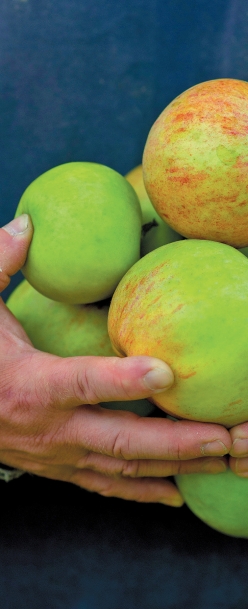Little Orchards Everywhere
Like some kind of modern day Johnny Appleseed, Rob Reiman and crew are on a mission to scatter orchards and berry bushes around the Kansas City metro area. Here in a schoolyard or church lot, there in a community park or alongside a nonprofit office – wherever there might be an unmet hunger for fresh fruit.
“We’re going into tough neighborhoods where people are often eating the worst kinds of food,” says Reiman, executive director of The Giving Grove. “We want to make a big impact on health.”
The Giving Grove is a new organization dedicated to planting and arranging for stewardship of edible tree and bramble gardens. An affiliate of the Kansas City Community Gardens, it shares office space with that group at 6917 Kensington Ave. on the edge of Swope Park. In addition to Reiman, the original start-up staff included a horticulturist and an outreach specialist. In August, Reiman added Matt Bunch, who had been managing the Heartland Harvest Garden at Powell Gardens, as lead horticulturist.
Having knowledgeable staff is crucial, but The Giving Grove’s business model relies equally importantly on volunteers. “Our whole model is based on neighborhoods and nonprofits being the caretakers of what we plant,” Reiman says. “We will only engage if an organization will commit two people to be trained as stewards – watering, pruning and scouting for disease and insects.”
Once the orchards and bramble gardens are established, the fruit they produce is free for the taking, although it’s not really meant for well-to-do suburbanites to gather for making pies. Any extra fruit will be gleaned by the Society of St. Andrew and delivered to food pantries, and at some locations managed by churches, 100 percent of the harvest will be redistributed.
The Giving Grove held a kick-off last fall by preparing grounds at Hale Cook Elementary School in Waldo, where participants included the Kansas City Chamber of Commerce Centurions, the Kansas City Community Gardens and Friends of Hale Cook. Last spring was the first full planting season. Staff and volunteers planted Hale Cook and 12 more sites with about 200 fruit trees, 150 berry bushes, strawberries and a small number of nut trees. A second planting effort will take place this fall.
The organization works with a short list of nurseries—Stark Brothers, Grandpa’s, Cummins and Raintree—from which they purchase sturdy varieties of mostly semi-dwarf, bare-root fruit trees and plants (see the list at givinggrove.org). Sometimes the soil is amended first with compost and topsoil from Missouri Organic, and in the future, they may add a few perennial herbs and vegetables to the mix of edibles.
“The most important thing is to use the right plant,” says Reiman.
“All apple trees are not created equal.”
A long-time gardener, Reiman’s own backyard contains pear, peach, plum, apple, cherry, fig and paw-paw trees, plus a variety of berries. He was leading an environmental ministry at his church, St. Paul’s United Methodist in Lenexa, when he met up with several individuals who had worked on hunger issues and felt there had to be a better way than relying solely on food pantries. Eventually a Giving Grove executive team was formed: Kevin Birzer, an investment manager at Tortoise Capital Advisors; Greg Finkle of Finkle/Williams Architecture; Ray Makalous, who coordinates the fundraising; Lisa Ousley, a director at the Society of St. Andrews; and Jill Quigley, a former Kansas state representative. Later, the team added Ben Sharda, executive director of the Kansas City Community Gardens and Becky Johnston, vice president of the KCCG Board.
“We have a really nice blend of people with good business savvy,” says Reiman, a retired principal from Deloitte Consulting. “We’re designing these edible tree gardens to be a sustainable food system that will be around a long time.”
Food foraging movements and community orchards are fast becoming popular in many cities. Seattle is developing perhaps the largest public orchard in the U.S. on a 7-acre lot in the middle of a working class neighborhood called Beacon Hill. Los Angeles recently opened its first public fruit park, Fallen Fruit. Last fall, the Philadelphia Orchard Project planted its 500th fruit tree and 1,000th berry bush.
Closer by in Lawrence, Kansas, organizers of the Fruit Tree Project are growing a community orchard as well as inviting private landowners to register their fruit trees if they’d like to donate some of the gleanings to food pantries. And several inner Kansas City neighborhoods are planting their own mini-orchards on community lots, sometimes through a Skills USA project. It’s all part of an effort to transform the landscape in limited resource areas and connect the residents with nature and healthy eating.
“There’s a huge interest right now in the urban core micro-orchard concept, and we’re very excited about that,” Reiman says. “The very center of what we’re trying to do is feed people. We also want to engage young people who have lost touch with where food comes from.
And a third dimension is creating a reason for the community to come together.”
He already can see that happening. Last spring The Giving Grove partnered with Wyandotte Countians Against Crime to plant 22 trees at 21st Street and Central Avenue in Kansas City, Kan. A school bus stopped to drop off some middle school students, who sauntered over to ask what they were doing. “We’re planting fruit trees for you,” Reiman explained. In five minutes, the students were helping dig holes.
There are plenty of challenges. Finding a source of water for the young trees is one, and finding stewards to care for them is another. Some type of endowment and/or corporate sponsorships would be nice. And a more comprehensive volunteer network needs to be established. “We had about a dozen people planting 45 trees with hand shovels in one neighborhood,” Reiman says. “It wasn’t enough.”
He’s hoping that school groups, scouts and faith-based congregations will step up to help tend the plantings and harvest some of the fruit for food pantries. He’d also like to develop a network of edible tree gardeners similar to the master gardener networks in Missouri and Kansas, with experienced stewards serving as coaches for others.
He believes this might work. “People who like growing things have a certain kind of heart, don’t you think?” he asks.
While a basic plan for the projects exists, The Giving Grove board has come to realize that each community orchard is unique. They recently modified their mission statement to remove a phrase about developing “replicable models.”
Some places where The Giving Grove already has planted fruit trees and berries include:
- Kansas Bhutanese Community Garden
- Cherith Brook, a residential Christian community that provides a safe place with showers, clean clothes and nutritious food to anyone in need
- Conception Community Garden at the New Rising Star Missionary Baptist Church
- Hale Cook Elementary in Waldo
- Barstow Elementary
- Independence Habitat ReStore
- Jerusalem Farms, a Catholic community run by Avila University
- Mitzvah Garden KC at Village Shalom
- Metropolitan Lutheran Ministries
- St. Paul’s United Methodist Church of Lenexa
- Wyandotte Countians Against Crime in Kansas City, Kansas
“Our program takes a mostly organic approach,” notes Reiman, who says that each orchard steward receives a copy of a book, “The Holistic Orchard” by Michael Phillips, as a guide.
The ultimate goal is for the six-county Kansas City area to have hundreds of edible tree gardens or micro-orchards flourishing throughout both the inner core and the suburbs in the near future. And because many of the semi-dwarf trees have a 25 to 30-year lifespan, The Giving Grove plans to add trees to established plantings every five to ten years.
“I think we’ve got something that’s going to be really big. Not that far down the road, other cities may be using our model,” says Reiman.
“We want these little orchards to be around forever."





